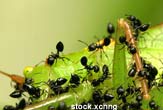Ants 'Hate Each Other' But Work Together

Different ant species can coexist because, as the saying goes, where one is weak another is strong.
In what researchers describe as “un-peaceful coexistence,” multiple ant species stake out the same territory and compete for the same food, but no single species wins out since some are better at finding resources and others better at guarding them.
The scientists looked at six ant species living in a desert environment and developed mathematical models to determine how different variables, such as the availability and size of food resources, affected the overall system.
Some ants, they found, sent out many scouts to look for food, so their species was better at finding resources, while others kept more ants in the colony and were better able to defend what was brought back, researcher Fred Adler of the University of Utah told LiveScience.
Adler and colleagues described this as a “dominance-discovery trade-off.”
Not only were some ants better at locating the food and others at holding onto it, but each was proficient at scavenging for a particular type of food.
Smaller ants were better at recovering a large piece of food because they could break it into tiny pieces then work as a team to haul it back home. When the species competed for a smaller piece of food, however, larger ants would stomp into the fray and drag the entire piece off before the smaller ones could break it down.
Get the world’s most fascinating discoveries delivered straight to your inbox.
Not all the ant species were so specialized though. Two were masters of all trades—adept at both finding and defending resources of any size. Unluckily for them though, they were also the targets of parasitic flies, which lay their eggs on these ants, eventually killing them in a particularly gruesome death by decapitation. If these flies were around, the ants would relinquish their hold on the resources and another species would move in.
The take-away message is not that utopian co-existence is possible, since after all, said Adler, “these species hate each other.” It is more about understanding the natural limits of organisms: No single species wins every time, because it is impossible to be well adapted to do everything. From an evolutionary perspective, he explained, “there are limits to how well you can design something.”
Humans, he added, are the only species that seem to be able to break these constraints—owing to our intelligence, not physical capabilities.
The study is detailed in the March issue of The American Naturalist.
- Images: Ants
- Ants Ambush Prey from Foxholes
- Ant Power: The World's Fastest Bite
- How Ants Navigate
- All About Bugs
